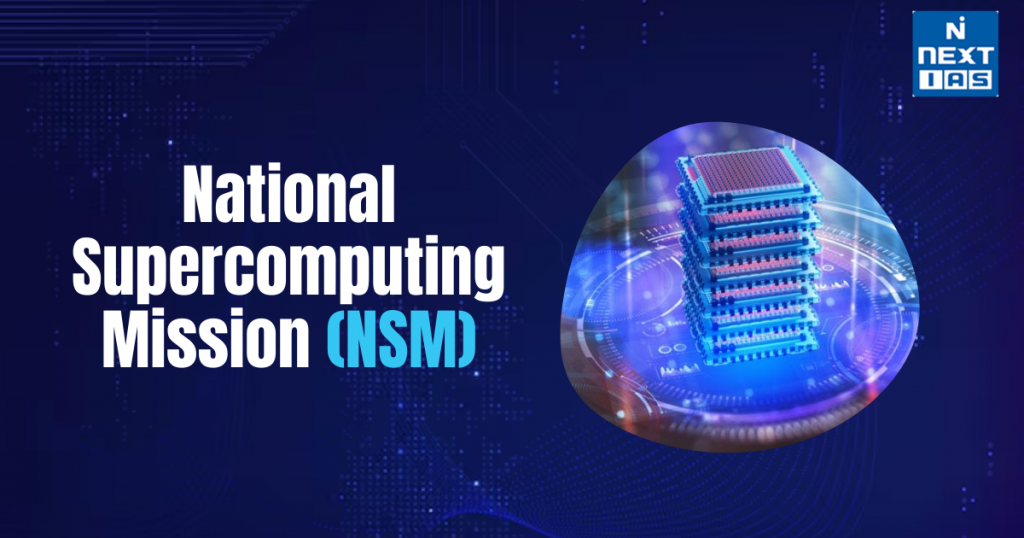
National Supercomputing Mission (NSM) has been set up to provide the country with supercomputing infrastructure to meet the increasing computational demands of academia, researchers, MSMEs, and startups. It is a first of its kind attempt to boost the country’s computing power. National Super Computing Mission is steered jointly by the Department of Science and Technology (DST) and Ministry of Electronics and IT (MeitY) and implemented by the Centre for Development of Advanced Computing (C-DAC), Pune and the Indian Institute of Science (IISc), Bengaluru.
About the National Supercomputing Mission (NSM)
- The National Supercomputing Mission was launched in 2015 with the goal to connect national academic and R&D (research and development) institutions with a grid of over 70 high-performance computing facilities, which would enable India to leapfrog to the league of world-class computing power nations.
- NSM is being implemented by the Department of Science and Technology (DST) and the Department of Electronics and Information Technology (DeitY), Govt. of India at an estimated cost of Rs. 4,500 crore over a period of 7 years. The Mission supports the government’s ‘Digital India’ and ‘Make in India’ initiatives.
- In Supercomputing, India is ranked at 74 globally and has only 9 supercomputers out of more than 500 in the world. NSM has been conceptualised and evolved taking into account the ever increasing computing demand of our scientific and academic community, international technology trends and roadmaps, strategic importance and emergence of supercomputing as a benchmark for scientific and technological advancements.
- The Mission envisages empowering academic and R&D institutions spread over the country by installing a vast supercomputing grid comprising of more than 70 High-Performance Computing (HPC) facilities.
- These supercomputers will also be networked on the National Supercomputing grid over the National Knowledge Network (NKN). The NKN is another programme of the government which connects academic institutions and R&D labs over a high speed network.
- Academic and R&D institutions as well as key user departments/ministries would participate by using these facilities and develop applications of national relevance.
- The Mission also includes development of highly professional and skilled human resource for meeting the challenges of development of these applications.
- The implementation of this Mission would bring supercomputing within the reach of the large Scientific & Technology community in the country and enable the country with a capacity of solving multi-disciplinary grand challenges of national and global relevance.
- NSM intends to attain global competitiveness and ensure self-reliance in the strategic area of supercomputing technology.
- The application areas include: Climate Modelling, Weather Prediction, Aerospace Engineering, Computational Biology, Molecular Dynamics, Atomic Energy Simulations, National Security/ Defence Applications, Seismic Analysis, Disaster Simulations and Management, Computational Chemistry, Computational Material Science and Nanomaterials, Astrophysics, Large Complex Systems Simulations, Cyber Physical Systems, Big Data Analytics, Finance, Information repositories/ Government Information Systems etc.
Features of National Supercomputing Mission
- Indigenous Supercomputing Development – The mission focuses on designing, developing, and deploying supercomputers using Indian technology, reducing dependency on foreign imports.
- Multi-Phase Implementation – NSM is being executed in phases, with an aim to install over 70 supercomputers across India’s academic and research institutions.
- High-Performance Computing (HPC) – The supercomputers are used for advanced research in areas like weather forecasting, climate modeling, drug discovery, AI, and big data analytics.
- Make in India Initiative – Emphasizing indigenous manufacturing, NSM promotes the development of processors, servers, and software within India.
- Capacity Building and Skill Development – The mission includes training programs to create a skilled workforce in high-performance computing and AI-driven research.
- Industry and Research Collaboration – NSM encourages partnerships between academia, industry, and research institutions to drive innovation.
- Energy-Efficient Computing – The supercomputers developed under NSM are designed to be energy-efficient, ensuring sustainable computational power.
Lacunae of the National Supercomputing Mission (NSM)
- Slow Implementation – The mission, launched in 2015, has faced delays in setting up supercomputers across institutions. The pace of deployment has been slower than expected, affecting research progress.
- Limited Indigenous Hardware – While NSM promotes Make in India, the country still relies heavily on foreign components, including processors and memory chips, due to limited domestic semiconductor manufacturing capabilities.
- Funding Constraints – Insufficient financial allocations and delays in fund disbursement have slowed research, procurement, and infrastructure development under NSM.
- Skilled Workforce Shortage – India lacks a sufficiently trained workforce in high-performance computing (HPC) and artificial intelligence (AI), limiting the optimal use of supercomputers for research.
- Energy Consumption Concerns – Supercomputers require massive power, and India’s energy infrastructure struggles to support large-scale computing while maintaining sustainability.
- Limited Industry Collaboration – While NSM aims for academia-industry partnerships, private sector involvement remains low, reducing opportunities for real-world applications and innovation.
- Lack of Software Ecosystem – India lags in developing indigenous HPC software, depending on foreign technology for supercomputing applications.
Key Pointers for National Supercomputing Mission (NSM) – UPSC CSE Prelims
- Launched: 2015
- Ministries Involved:
- Ministry of Electronics and Information Technology (MeitY)
- Department of Science and Technology (DST)
- Implementing Agencies:
- Centre for Development of Advanced Computing (C-DAC)
- Indian Institute of Science (IISc), Bangalore
- Objective: Develop a self-reliant supercomputing ecosystem in India for scientific research and industrial applications.
- Phases: Multi-phase implementation, targeting over 70 supercomputers across institutions.
Way Forward
To enhance NSM, India must accelerate implementation, boost indigenous semiconductor manufacturing, increase funding, and strengthen industry-academia collaboration. Developing a skilled workforce in high-performance computing (HPC) and promoting energy-efficient supercomputing are crucial. Investing in indigenous software ecosystems will ensure long-term self-reliance and global competitiveness in supercomputing technology.
Conclusion
The National Supercomputing Mission is a crucial step in advancing India’s technological and scientific capabilities. While challenges exist, strategic improvements in indigenous hardware, funding, and skilled workforce development can enhance its impact. A well-executed NSM will position India as a global leader in high-performance computing and innovation.






